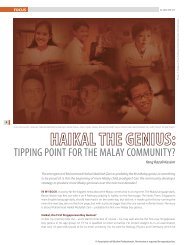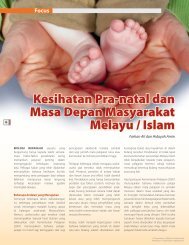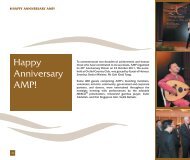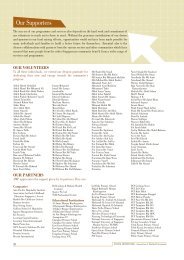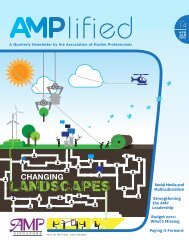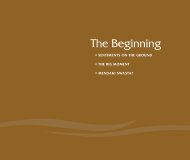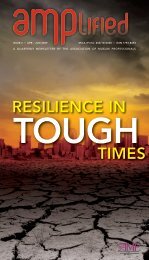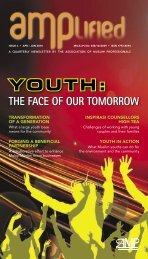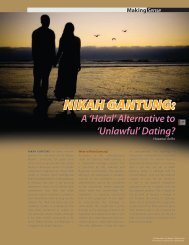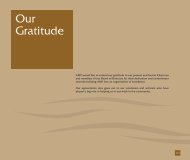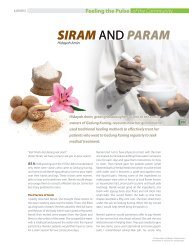Issue 10: Apr - Association of Muslim Professionals
Issue 10: Apr - Association of Muslim Professionals
Issue 10: Apr - Association of Muslim Professionals
- No tags were found...
Create successful ePaper yourself
Turn your PDF publications into a flip-book with our unique Google optimized e-Paper software.
o T H O U G H THARD TRUTHS ABOUTINTEGRATIONby Mohd Nizam IsmailThe recent brouhaha over remarks made on Islam and integrationshows that the issue <strong>of</strong> integration is one which is well alive inSingapore and that there are two important (and fundamental)questions relating to integration that needs to be addressed:1) Who should bear primary responsibility for integration?What is the responsibility <strong>of</strong> the State and majoritycommunities in this?2) What is the end state <strong>of</strong> integration in Singapore(if there is one)?Who is responsible for integration?Turning to the first question on who should have responsibilityfor integration, I would argue that the State should carry theprimary responsibility. It would be in the interest <strong>of</strong> the State toensure that there is integration between the different ethnic andreligious communities that it governs.Whilst we have seen efforts at fostering integration (includingthe setting up <strong>of</strong> OnePeople.sg which is tasked to ensure racialharmony), more can be done.I would argue that policies such as having “race” mentionedin our identity cards, publication <strong>of</strong> data along racial linesand other forms <strong>of</strong> racial-based policies tend to highlight oreven exaggerate racial differences. This is putting aside otherinherent difficulties <strong>of</strong> force-fitting “race” onto children <strong>of</strong> mixedmarriages. In some countries, it is illegal to make reference tothe race <strong>of</strong> a person in relation to certain practices.Another factor that needs to be seriously relooked is thecurrent model <strong>of</strong> relying on ethnic-based self-help groups (e.g.MENDAKI, CDAC, SINDA, EA, or even AMP) as the primaryprovider <strong>of</strong> self-help to different communities.A lot <strong>of</strong> the issues (for example, education underattainment,dysfunctional families, and juvenile delinquency) cut acrossdifferent ethnic communities. Oftentimes, the argument thathelp is best administered through someone <strong>of</strong> the same raceis exaggerated. A counsellor who is sensitive to the needs <strong>of</strong>someone <strong>of</strong> a particular race is equally effective in giving helpto a family in need. Also, it matters not whether a tutor whois helping an underachieving student comes from a differentethnic background.Having a race-blind approach in coming up with self-helpprogrammes could avoid any perception that a disadvantagedcommunity comes from a particular ethnic background, and thathelp can only be provided by someone from your same ethnicbackground. This is over and above efficiencies that can begained by pooling together counsellors or educational experts.I now turn to the role <strong>of</strong> majority community in integration. Here,the odds are always inherently stacked against the minoritycommunities to do their bit to integrate. It would be far easierfor the majority community to facilitate integration by reachingout to minority communities. This is not to say that the Malay/<strong>Muslim</strong> community (or other minority communities) should shirkaway from any responsibility to integrate. If the Malay/ <strong>Muslim</strong>community has made special efforts to integrate with othercommunities, surely there has to be a greater expectation on themajority community – being in a more advantageous position- to facilitate integration.What is the end state <strong>of</strong> integration?The more fundamental question that has yet to be addressedis this – what exactly are we working towards? What is theend state <strong>of</strong> integration? Can we reach a stage where we canhappily conclude that Singapore has achieved integration, andtherefore there is no pressure on any community to put in place“special efforts” to integrate?The absence <strong>of</strong> clarity <strong>of</strong> an end state <strong>of</strong> integration is anomission that may cause confusion – as different groups mayend up working in different (or worse, conflicting) directions.It may be easier to define what integration is by stating what itis not.Integration is not assimilation. Integration is not an end-statewhere Singaporeans adopt only one Singaporean identity andput aside whatever ethnic or religious identities that they have.If it is at all possible to have an end state to integration, theremust be a rich diversity <strong>of</strong> practices.I prefer to imagine an ideal state <strong>of</strong> integration as one wherethere is free association <strong>of</strong> people from different racial or religiousbackgrounds. There is equal opportunity to all irrespective <strong>of</strong>ethnic or religious backgrounds. A manifestation <strong>of</strong> such an idealstate <strong>of</strong> integration would be to see minority communities beingactually represented in terms <strong>of</strong> employment, political influence,socio-economic standing, and educational attainment. The Statedraws on the richness <strong>of</strong> diversity <strong>of</strong> different groups and seesthat as a strength rather than a liability. There would be no needto force conformity <strong>of</strong> any particular group to the identity <strong>of</strong> abroader community.If we accept this ideal state <strong>of</strong> integration, then it becomes clearthat the role <strong>of</strong> the State in achieving this ideal becomes critical.This is because achieving such an ideal only becomes possible ifpolicy changes are made to remove barriers to integration.To reach this end state, the focus would be on looking at areaswhere there are impediments to equal opportunity, and how wecan strengthen minority communities such that they will be ableto meaningfully seize the opportunities that are present.8 ISSUE 8 4 ISSUE • OCT <strong>10</strong> – DEC • APR 2009 – JUN 2011© <strong>Association</strong> <strong>of</strong> <strong>Muslim</strong> Pr<strong>of</strong>essionals. Permission is required for reproduction.



